Episode #2: DLF’s Content Marketing Strategy with Karan Kumar
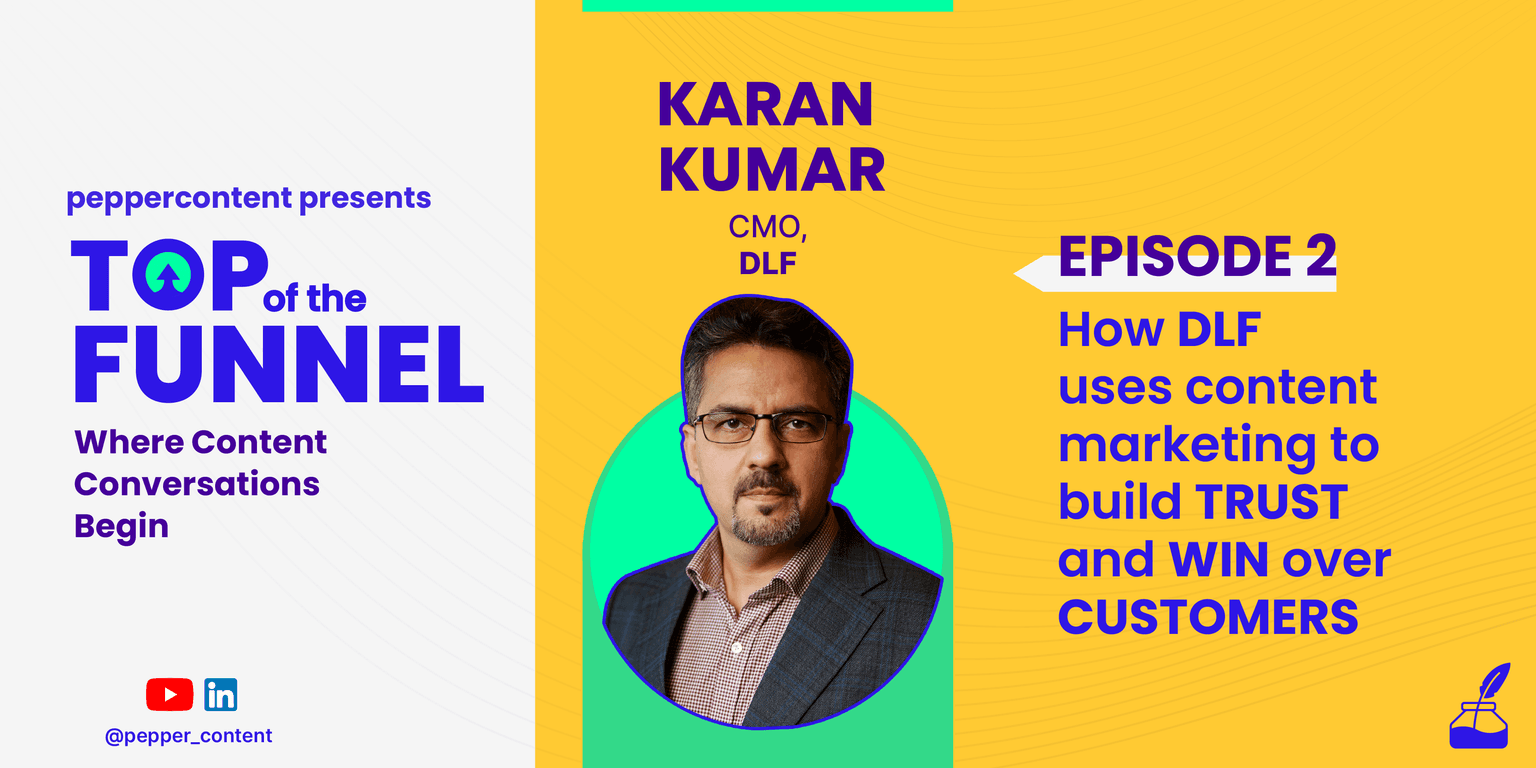
Content marketing is an important tool for lead generation across all industries. Bite-sized video content is all the rage now, followed closely by partly animated and then, static content. Content and marketing professionals have to upgrade their game by designing relevant content that can be optimized across platforms, keeping consumer intent in mind.
Natasha Puri, Content Marketing Lead at Pepper Content, talks to Karan Kumar, the Chief Marketing Officer of DLF. Karan has over 20 years of experience in the world of marketing and during this time, he has worked for various industries like ITC, FabIndia, to now DLF. He firmly believes that one has to combine their existing domain knowledge with the upcoming trends and do a great deal of learning and unlearning to stay afloat in the industry.
Natasha Puri: Hello everyone. Welcome to the Top of the Funnel, the series where conversations about content begin. Our guest today is Karan Kumar, the Senior Vice President, and Chief Marketing Officer at DLF, and has held similar roles at companies like ITC and FabIndia. This chat promises to be very informative and insightful for Karan has considerable experience in a wide range of industries, from FMCG to FMCD brands.
Could you tell us about your journey so far, and what are you handling at DLF, and the role of content in it?
Karan Kumar: At DLF, currently, I have been around for a little over a year, close to 15 months. I head Marketing as senior vice president and chief marketing officer for the residential business, which means everything that we construct goes into making a home all over the country, across projects, across segments, across cities. I take care of fundamentally three parts of Marketing, the pre-launch, pre-sales, everything that goes with making a launch successful, and thereafter what’s called sustenance marketing in the real-estate parlance, marketing projects that have been launched which still has a certain amount of residual inventory to it.
I have spent about 20 odd years in the industry but never done real estate before this. There have been a great many learnings and a great many unlearning of things. But the idea is to bring forward what’s learned over ways, sectors one has worked with, for of course many odd years and get those best practices to work for this particular sector, this industry as well. Some parts of it which can be brought forward and applied in a fairly straightforward manner and there are other parts of it that need to get redesigned or customized to the context of real estate, the consumers, the customers, the trade partners that you are working with.
Natasha Puri: How has the transition been like, from FabIndia to DLF? How is marketing at DLF different from FabIndia?
Karan Kumar: In the 20 odd years that I have been around, I have done 16 and a half years at ITC, where I first joined out of campus. At ITC, I’ve worked across various businesses, some new, nascent, emerging businesses, and some older, more matured businesses. I have worked across business and product groups like tobacco, lifestyle, and retailing, stationery products for kids and adults, packaged food, which itself has become a large play for ITC now, so on and so forth. When I left ITC, I had been working with the lifestyle and retailing division. From there, the move to Fab India was a relatively smoother one.
One had a context of retail and fashion apparel. But Fab India had its own set of challenges. It is a very differently structured organization with a very different work philosophy, ethos, and a beautiful set of people. The product categories expanded a bit, as one was not only talking about apparel from a lifestyle point of view but also home goods, a certain amount of personal care, packaged goods, and packaged grains as well.
I was the first Chief Marketing Officer that Fab India had ever appointed so obviously the role came with a certain degree of challenges, putting together a team, reorganizing certain current internal structures, putting together a slightly longer marketing vision, so on and so forth. From there, I think that when I moved to DLF, real estate was not something that I was familiar with. What drove me into this was a certain hunger that all of us as business leaders should possess, a hunger to scale what is new, to do what has not been done till now, and demystify the challenge and make it work for you. Do things that you have done in the past but you bring them to a new context and make them work for the new context.
At the fundamental level of marketing and marketing anchored business leadership, the challenges are fairly similar in product groups and customer segments. The challenges are for brands to be able to build trust, to be preferred over other brands, and that preference has to lead to closures, or sales, or revenue, or whatever the jargon is for each industry and sector. Summing up- sales, brand preference, anchored fundamentally in brand trust, leads to sales closure, and revenues and cash flows leads to a healthy business.
It is not just enough to sell. You have to sell profitably, with an ever-expanding margin, so that everybody makes the right amount of money. Whether you are selling a 50 paise candy to a kid, or a 25,000 jacket to a grownup young man, or stationery to kids, or a bag of Aashirvad Aata to a housewife, the premises are similar. When you are selling a house, you have to know your target audience. How do you get to play out this premise in different contexts? What is the kind of media ecosystems you activate? What is the kind of trade marketing and channel partner exercises that you undertake? The premises across all industries are similar. It is up to you to bring your past learnings and unlearn some of them to realize the stakeholders’ importance to drive business revenue to a different sector.
Natasha Puri: When you spoke, one word that resonated for me, as someone with no experience in this industry, was trust. When you are asking people to buy a home, you are asking them to make a huge transaction. It is an emotional appeal at the end of the day. What does marketing mean in real estate? Is this where the buzzwords about storytelling come in?
Karan Kumar: Storytelling is needed to sell anything, from a 5 rupee pack of biscuits to a 25 lakh product. Trust in home building is on another level. Storytelling would be an extremely relevant role in the context of real estate, given the fact that your ticket value is the highest that you would probably end up spending on any single product in your life, second to maybe an expensive car. Storytelling is counterintuitive across industries. When people are looking at products in certain industries, the stories they want to hear are different from the stories told for products of another category.
In the case of real estate, you want to know not only the number of bedrooms and square feet of the building but also the micro-market. You are invested to know what will come around the product. What kind of community would I be living in? What kind of habitation will I be looking at? What kind of neighbors will we have? What kind of amenities will come when I buy the product? What is going to be the overall upgrade to my lifestyle when I move into this kind of product? What’s going to be my accessibility outside that microsystem?
An honest and transparent dialogue goes a long way. You have to tell the story without making any kind of overstatements, or reporting any kind of factual inaccuracies. The only thing that I want to emphasize here is, and not just in the context of real estate, every brand that needs to be a successful brand must tell very honest and authentic stories, not just real estate, whether you are selling a pack of biscuits or a bag of chips, there should be no hyperbole. The sector has been plagued by some brands playing at half-truths.
People engage with DLF, which has been around for roughly 75 years, because of our credibility, the legacy that we have delivered, the promises that we have kept, and the commitment that we always stood steadfast with. Stories should not be confused with taking creative liberties by reporting anything that is not accurate. The stories should be relevant to the category and help the consumer to make an informed decision.
Natasha Puri: Is anyone handling content exclusively at DLF, or is it something that runs across the entire department? What is the role that content essentially plays?
Karan Kumar: We have fundamentally structured the marketing department to different islands, as it were. One island is very typically an island that is represented by the brand management team, who are very directly mapped to individual projects, individual sales team members. And their job is to clearly understand the requirements and the imperatives of the sales teams and to ensure that we have a fairly comprehensive input package for both customers and trade, and are able to realize the kind of sales velocity, margin intentions that we have. But these are people, who would be pure brand managers at an FMCD kind of an environment as well.
The other island of the marketing team, who we have just started hiring represents certain domain expertise, beyond a generalist brand manager role. They are specialists not especially from the real estate background, but specialists in content, or performance marketing, or media and PR, or the events and brand alliance space. They would service brand managers as external customer support. The brand manager comes to them with the problem and they need to provide a solution for it.
Domain specialists may or may not have an understanding of real estate, but are experts in the area that they represent and brand managers are generalists to the extent of understanding product, market sizing, research, trends, pricing, so on and so forth. The idea is to create a cohesive team, one island that services and supports the other island.
From a content point of view, our brand portfolio is our product and project logistics, that we have from time to time. So, he looks after that and he is also responsible for handling and managing social campaigns, which are different than digital performance campaigns.
Natasha Puri: What are the platforms that work best for this industry?
Karan Kumar: The platforms are pretty much similar across all industries. These are social platforms like Linkedin, Instagram, and Facebook. The performance metrics on Instagram are very different from that of Linkedin so, depending on the kind of messaging you want to do, choose your platform. The only two other kinds of platforms which are more unique to real estate are real estate aggregator platforms like 99 acres and MagicBricks.
Natasha Puri: With the video, audio podcast boom that is happening, which format do you think is working for real estate?
Karan Kumar: The rules are very similar to the non-real estate environment as well. Obviously, video works better than only static. Engaging content which is partially static or partially moving content, like gifs, also works well. So, after video, partly animated content comes second, and static images come third. Podcasts are relatively a new phenomenon. People want to know more about what’s happening in the industry for example, new regulations, new government laws. The RERA Act itself has been quite a game-changer for the industry People want to know more about RERA, its applicability, and so on.
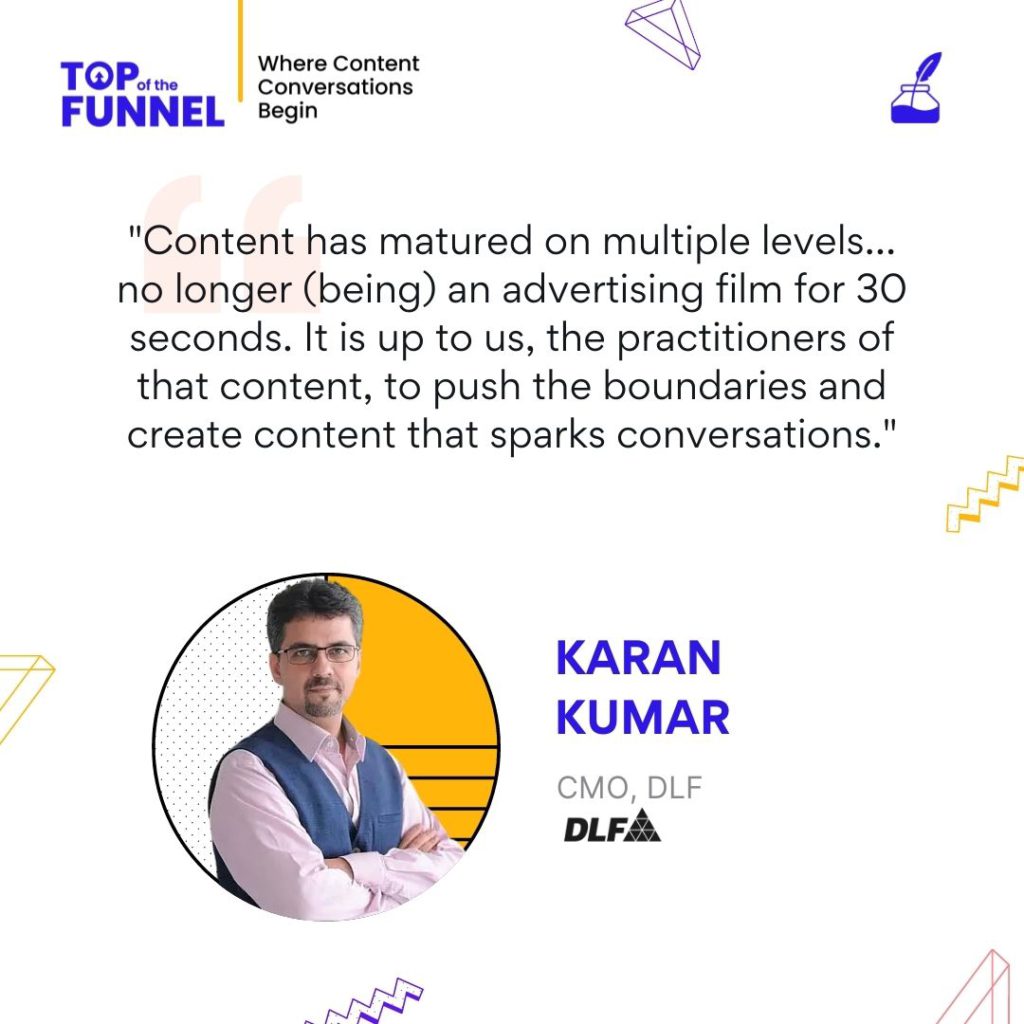
Natasha Puri: You’re been a marketer for the longest time. How far do you think the content has come in the marketing function specifically in real estate?
Karan Kumar: Content has matured in multiple levels, also at the levels of people who create content. It is no longer an advertising film for 30 seconds, but marketers and business leaders have experimented with other forms of content and formats. The Mutual Funds Federation of India had done some content on an OTT platform in the form of a series and the fundamental premise was to educate people about Mutual Funds. This is an example of how content is becoming more engaging.
For real estate as well, there would be conversations around the product in the community, around the habitation, about the location, all of which will be anchored through content. As an industry, it is up to us, the practitioners of that content to push the boundaries and create as much content as we can create in some of these conversation points. There is a huge hunger for it. People want to know more.
Natasha Puri: Is the customer also changing?
Karan Kumar: Across categories, customers are being more inquisitive. They want to be better informed. Customers are also massively connected in the social networks so, conversations, referrals, and affirmations from friends, family, and social cohorts become very important. They want to hear other people’s feedback or if they’ve had any good or bad experiences with a specific brand and so on and so forth. I cannot help repeating that honest, truthful, and authentic content is needed to drive conversations.
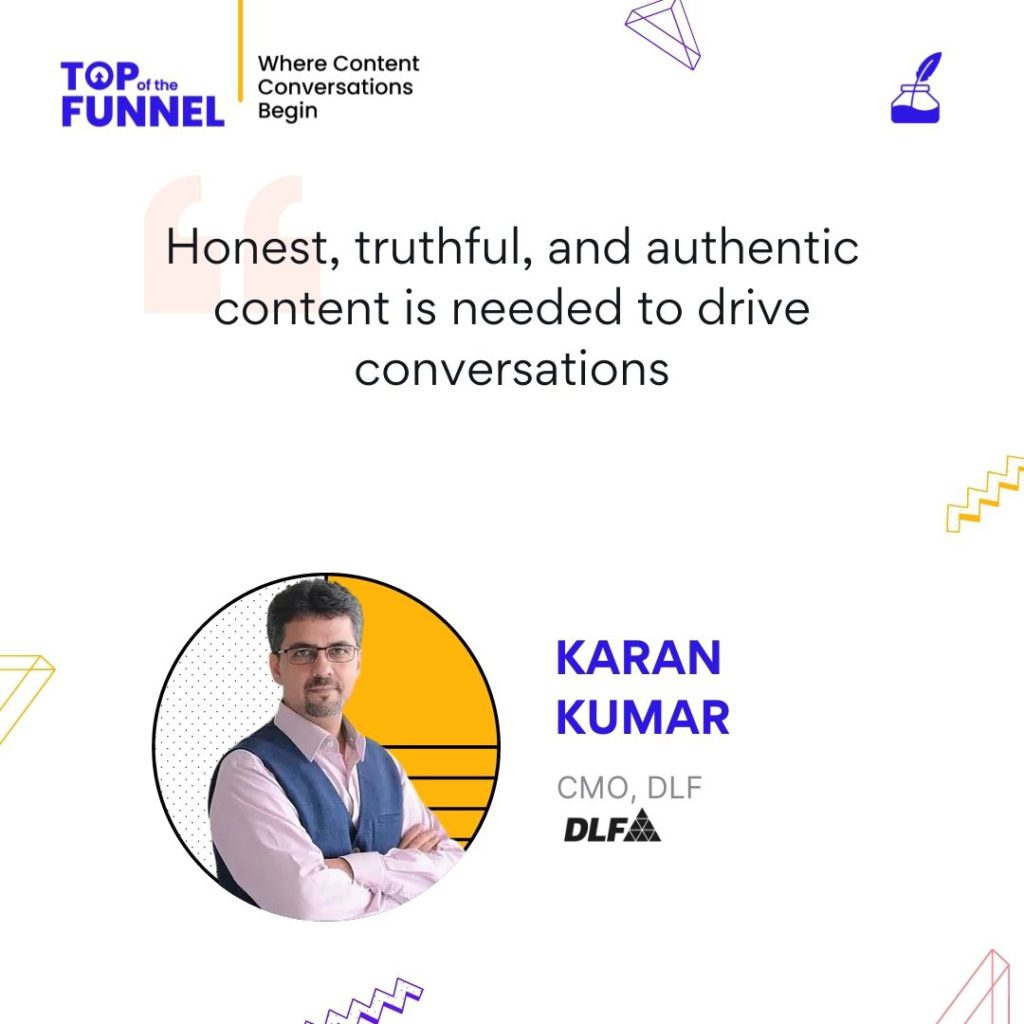
Natasha Puri: Would you like to talk about some of your campaigns that have been successful?
Karan Kumar: We work with a talented team, both internally and externally. By external, I mean a set of agency partners.
Out of all the campaigns that we have done, one that also earned certain recognitions was the campaign around DLF Cares. It was a multi-platform campaign. It was not just a social or digital campaign, but an on-ground campaign, where the entire aspect of engaging your community and taking care of your community played out at both a physical level and a social community level.
What happens when things go south on a campus? Campuses had around fifty people, staying in for six months in the pandemic, taking care of essential needs like sanitization, cleaning of common spaces, electricity, water supply, and so on. It sparked a lot of positive conversations about the brand and that also led to conversions or revenue generation.
Natasha Puri: At Pepper, we say every company is a content company. What do you think?
Karan Kumar: Yes, of course. Every brand, whether FMCG, FMCD, media, real estate, is the owner and creator of content. Every brand needs a certain amount of messaging to be done, a certain amount of conversions to happen, and a certain kind of engagement to occur. Every brand is the owner, creator, and distributor of its content.
Natasha Puri: How do you plan content distribution?
Karan Kumar: For me, the distribution part precedes the content creation part. You have to be very clear on what kind of channels you want to activate and use for content distribution and thereafter, create content that is unique, relevant, and high performing on that particular platform. Each platform can contribute to a certain aspect of reach, engagement, and lead generation. Otherwise, you kind of go about the wrong end of the stick, trying to place sub-optimal content on a platform.
Latest Blogs
Explore how Google’s 2025 AI search updates triggered ranking chaos. Learn actionable strategies to adapt your SEO for AI Overviews, zero-click searches, and SERP volatility. Stay ahead now.
Learn how to rank on AI search engines like ChatGPT, Perplexity, and Gemini by optimizing your content for authority, structure, and relevance. Stay ahead in AI-driven search with this strategic guide.
Explore the best healthcare SEO services for your medical practice. Improve online visibility and effectively reach more patients in need of your services.
Get your hands on the latest news!
Similar Posts
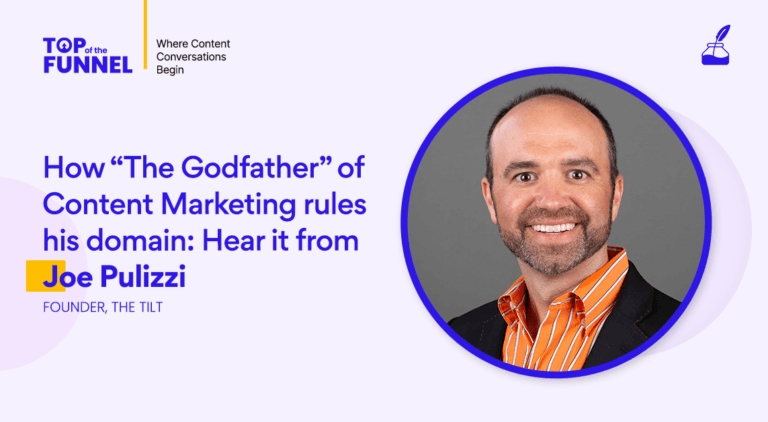
Expert Speak
18 mins read
Season 2 Episode #1 How “The Godfather” of Content Marketing Rules His Domain: Hear It From Joe Pulizzi
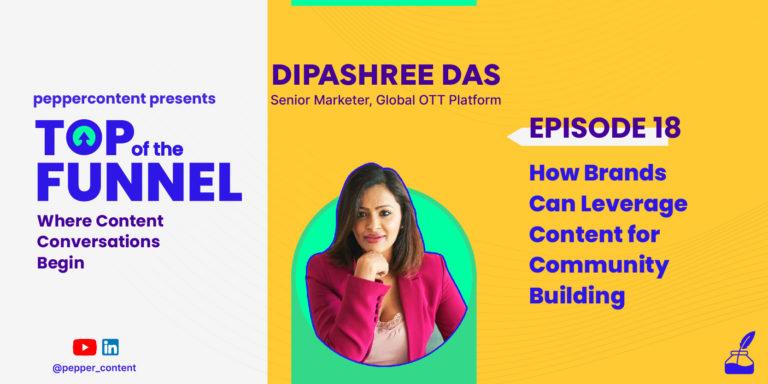
Expert Speak
16 mins read
Episode #18: How Brands Can Leverage Content for Community Building
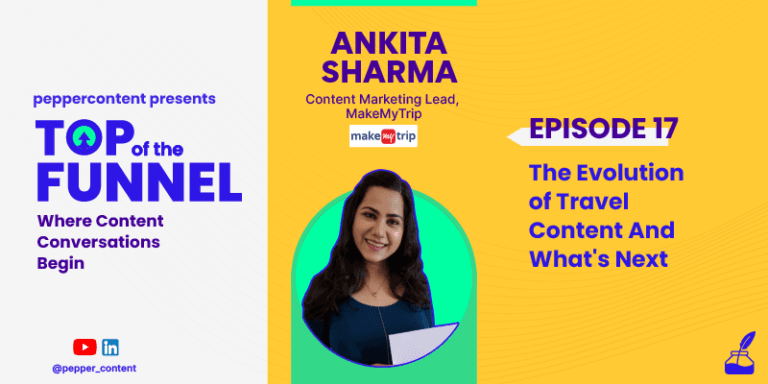
Expert Speak
11 mins read